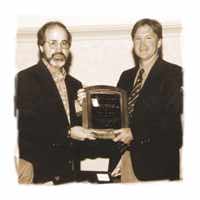|
|
|
|
Robert B. Sanet, O.D., left, presents Carl Hillier, O.D., the AOA Sports Vision O.D. of the Year award. |
THE
LAST WORD
A View of the Action
By Susan P. Tarrant
Carl Hillier, O.D., has great seats at the San Diego Padres baseball games. He gets an up-close view of the action because he has helped several players with their view of the action. In addition to being a practicing optometrist, he�s also a sports vision therapist. And so committed is he to the field that the American Optometric Association�s (AOA) Sports Vision Section honored him as its 2000 Sports Vision Optometrist of the Year for his efforts to develop and promote the field. A west coast guy, Hillier founded the Vision Rehabilitation Clinic at the San Diego Rehabilitation Institute at Alvarado Hospital. He is one of only 500 optometrists nationwide to be a certified Fellow in the College of Optometrists in Vision Development (COVD). He also serves as a consulting staff clinician at the Continental Rehabilitation Hospital. He practices out of the San Diego Center for Vision Care in the Lemon Grove section of San Diego.
So how does an O.D. get hooked up with professional athletes and evolve into a sports vision expert? For Hillier, it started with a volleyball. �In 1985, the Olympic committee wanted to find out to what extent athletic performance could be improved,� he explains. The AOA recommended Hillier�s colleague, Bob Sanet, and the two began working with the volleyball teams (men�s and women�s) because they were stationed right there in San Diego. The result? �It was the first time they were able to medal,� Hillier says proudly. Within 10 years, the word had spread, and other teams were seeking their vision expertise. �Skeet shooters, badminton players, golfers�all varieties of people,� he says. Among those people was baseball outfielder Greg Vaughn, a then-San Diego Padre (now with the Devil Rays) experiencing a bit of a hitting slump. The goal of visual training is the ability to see more information per unit time. Hilliard�s goal with Vaughn was to make him more visually aware of events that are occurring around him. As a baseball player, �if you can be in constant contact with ball visually, there�s more information available to you to make a physical response. While it�s physiologically impossible to track a ball that fast, you can be visually aware of the ball throughout the duration of the pitch.� Vaughn�s therapy involved working with strobe lights flickering around him, working with computer models that trained his eyes to identify the locations of quickly moving light targets, and more. �We trained him to be keenly aware of every temporal event that occurs around him, without missing any information that occurs along the way,� Hillier says. And it worked.




